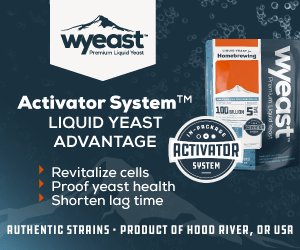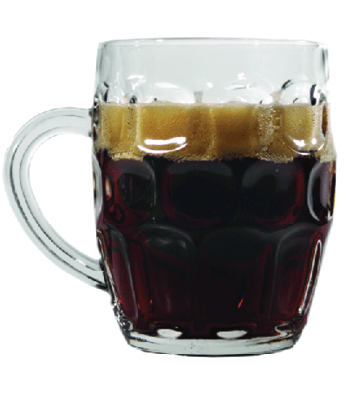American Pale Ale
American brewers have always been innovators. As European immigrants brought their traditions, their tastes, and their habits to new shores, they usually tried to continue their lives as they had begun them, but new cultures, new languages, and new environments demanded that they adapt.
Brewers were no exception. The earliest brewers in the New World were Dutch and British, producing ales and porters. (Among the best, apparently, were the so-called Puritans. Although they had some strict moral standards, they had no problem with ale at dinner.)
By the mid-1800s, however, a new wave of immigrants from Northern and Central Europe introduced different brewing styles and technologies. Pale, clear lagers rapidly replaced the once-popular ales. American breweries responded by adopting the new beer styles and incorporating indigenous grains (primarily corn), which allowed them to more easily brew very pale, very bright beers.
Eventually, ales had almost disappeared from the United States, although a few survived in the Northeast. Among these the finest was undoubtedly Ballantine’s, whose IPA was a serious attempt to preserve the British traditions, surviving almost to the dawn of the craft brewing age. Ballantine’s IPA was brewed to a respectable gravity (1.076), with plenty of hops (especially Brewer’s Gold, at 45 IBU), and was well-aged in oak. In time the brewery was acquired by a larger firm, the ale’s production moved to the Midwest, and the beer was toned down to a shadow of its former glory.
Other ales, of considerably less character, continued to be produced in the Northeast somewhat as novelty items. Many, in fact, were not true ales at all in the sense of being top-fermented.
Fred Eckhardt, author of Essentials of Beer Style, refers to them as “sparkling ales” and notes that they were brewed to compete with the American pale lagers. Like those beers the ales had “minimal taste profile, minimal hopping, and [were] lacking in hop bouquet.” In due time many of these beers were labeled “cream ales,” and whatever special character they possessed diminished further.
Most were “bastard ales,” formulated as a standard beer (although perhaps brewed to be just a little stronger) and fermented with the brewery’s regular lager yeast at a slightly elevated temperature for a slightly harsher, slightly fruitier taste. In some states the term “ale” was a label applied to beers of barely more than normal strength and had nothing at all to do with the beer’s method of production.
By the late 1970s and early 1980s virtually no true top-fermented ales were being produced in the United States, and America’s oldest brewing tradition was in imminent danger of disappearing entirely. The new tradition arose in California. Anchor Brewing Co. began tinkering with a real ale in 1975 (which eventually emerged as Liberty Ale), and New Albion (perhaps the first true microbrewery) introduced an ale a year later.
Within a few years homebrewers Ken Grossman and Paul Camusi launched Sierra Nevada Brewing Co., also in Northern California, and the craft-brewing industry began to take its first, faltering steps. No one at the time had any idea of how much would change, of course, or how quickly. Since California (and soon the Pacific Northwest) had no ale tradition to revive, the brewers were free to create a new one. Although they were, in a sense, emulating the British styles of beer, what emerged was a distinctly American version. In fact the American ale arose as the British ale was doing its best to sink.
In England industrial consolidation had caused small breweries, with their distinctive beers, to disappear. New, “convenient” technologies were replacing the delicate care of the old traditions and further defusing the character of the ales. Outrageous excise taxes, levied on the original gravity of the beer wort, caused brewers to curtail the alcohol content of their beers.
In the United States, however, consumers had begun a reaction to the long trend toward homogeneity in much of what they ate and drank. Boutique wineries were blooming, and newly affluent customers were looking at everything from mustard to pizza, coffee to bread, in search of new, more interesting flavors. The radical approaches of Sierra Nevada Pale Ale and Liberty Ale, and all the pale ales to follow, met with a surprisingly positive reception. In many ways Sierra Nevada’s ale can be taken as the prototype of the new American pale ale (in fact there are two Sierra Nevada Pale Ales, the draft version and a slightly different bottled version; both are classics).
With an original gravity near 1.048 to 1.052, Sierra Nevada’s ale is 10 to 15 points higher than a British equivalent. It is an all-malt beer, and the malts are very American (two-row pale, caramel, and dextrin). And significantly, the hop flavor is unabashedly American. In fact they are primarily the signature Cascade hops, citrusy and floral. Of all the American hops, Cascade and her sister varieties are the most obvious stamp of an American pale ale, unmistakable in their assault on the palate. Sierra Nevada Pale Ale falls smack in the middle of the style’s color range, somewhere between very pale golden and ruddy copper.
Unlike many British ales the Sierra Nevada yeast finishes very crisp and dry, with none of the characteristic British fruitiness. (The yeast is Sierra Nevada’s one serious link to the old American ale tradition — it is the same strain once used to brew the classic Ballantine’s ales.) Within a few short years American pale ales in their myriad variations began to appear throughout the Pacific Northwest and, eventually, around the country. In its purest form the style seems to still be a West Coast beer, with Eastern brewers slightly more influenced by British brewing revivals and traditions.
For a time it seemed as though the brewers around Portland and Seattle were competing to produce the most intense, most bitter, and most hoppy beer imaginable. Amazingly, there were a lot of us willing to egg them on, and the mid-’80s hopping rates went up and up. Among the great Cascade-drenched beers of the time were Grant’s Scottish Ale, Portland Ale, and the real Cascademonster, Pyramid Pale Ale. Other beers emerged with different blends of hops, and different character, but always with an eye to challenge and engage a new style of beer drinker.
With very few exceptions these first American pale ales were draft-only beers. Not only were bottling lines expensive and demanding, but liquor laws in Oregon and Washington had ensured that few drinking places served anything but beer and wine. An unusually high percentage of beer sales were in taverns, and drinkers were already used to the notion of going out for a beer.
As the craft-brewing movement spread and the demand for market share increased, brewers began to scale down the intense characters of their beers, and those that survive today are far more restrained than they once were. Admittedly, many of those beers were out of balance and one-dimensional, but for avowed hop freaks it was something of a Golden Age.
Plenty of American pale ales survive, of course. Like amber ales, American pale ales appear regularly on the lists of brewpubs and microbreweries. As amber ales are defined by their malt — caramel malt giving a characteristic copper color and sweet taste — American pale ales are defined by their hops. More specifically they are defined by the assertive use of American hops — good, pronounced bitterness and a noticeable, floral hop nose.
Although various hops are used, Cascades are nearly a cliche for the style. American pale ales can vary in color from very pale to copper and are generally medium-bodied and well-attenuated (dry). They are invariably all-malt, based on very pale American two-row malt, with some caramel and dextrin malts. Original gravities range from 1.045 to 1.060, generally in the middle of the range.
Mash cycles are very simple: single-step infusions at 152° to 154° F. Yeast strains are typically very neutral, although some rare examples such as Bert Grant’s Scottish Ale have a fruitier, more obvious contribution. Sierra Nevada’s strain is one of the most widely used in the microbrewery industry.
This yeast is aggressive, neutral, and capable of fermenting at relatively low temperatures (around 60° F). It is variously known as 1056 (Wyeast’s number), Chico (Sierra Nevada’s hometown), and American Ale. Since the brewery bottle-conditions its beer, the bottled products can be a source for the yeast, but nowadays its bottling procedure leaves very little to harvest.
Anchor uses open fermenters but most craft breweries use closed, cylindro-conical fermenters. Homebrewers can exercise their own options: open primary fermenters or carboys with blow-off hoses. Very good American pale ales can be produced at home with malt extracts and grains, as long as plenty of care is taken with sanitation and a good, healthy yeast starter is pitched. Hopping rates for partial-wort boils should be increased to make up for a lower extraction rate.
Dry hopping is particularly useful in brewing this style of beer, as it really emphasizes the hop nose. Another alternative is the use of a hop back, passing hot wort through a screen or basket of fresh, whole hops.
American Pale Ale
5 Gallons, Partial Mash
Ingredients:
- 8 lbs. Alexander’s Extra Pale Liquid Malt Extract
- 1 lb. two-row pale malt
- 0.5 lb. crystal malt
- 0.5 lb. cara-pils malt
- 2.5 oz. American Perle hops (6.5% alpha acid), for 75 min.
- 1.75 oz. Cascade hops (5.4% alpha acid), 0.75 oz. for 15 min., 0.5 oz. at end boil, 0.5 oz. dry hopped in secondary or keg
- 1 qt. Wyeast 1056
Step by Step:
Soak crushed grains in 0.5 gal. of 150° F water for one hour, then rinse with one gallon hot (170° F) water into kettle. Add malt extract and water to bring volume to 2.5 to 3 gals., depending on kettle size. Boil for 15 minutes. Add American Perle hops and boil an additional 60 minutes. Add 0.75 oz. Cascade hops and boil 15 minutes more. Add 0.5 oz. Cascade hops at end boil. Total boil is 90 minutes. Add wort to sufficient amount of pre-boiled, chilled water to bring volume to 5 gals. Aerate thoroughly and pitch yeast. Ferment in open primary at 65° F for one week or until head falls. Rack to carboy and finish fermentation at same temperature. If bottling, dry hop with 0.5 oz. Cascade hops in carboy and hold in secondary for two weeks. If kegging, add dry hops (in hop sack) at kegging time and condition cold for two weeks before tapping.
American Pale Ale
5 Gallons, All-Grain
Ingredients:
- 8 lbs. Great Western two-row pale malt
- 0.5 lb. crystal malt
- 0.5 lb. cara-pils malt
- 1.5 oz. American Perle hops (6.5% alpha acid), for 75 min.
- 1.5 oz. Cascade hops (5.4% alpha acid), 0.5 oz. for 15 min., 0.5 oz. at end boil, 0.5 oz. dry hopped insecondary or keg
- 1 qt. Wyeast 1056
Step by Step
Mash in 3 gals. of 170° F water for 90 minutes or until iodine test is negative. Sparge with 170° F water to 6 gals. Boil for 15 minutes. Add American Perle hops and boil an additional 60 minutes. Add 0.5 oz. Cascade hops and boil 15 minutes more. Add 0.5 oz. Cascade hops at end boil. Total boil is 90 minutes. Cool, aerate thoroughly, and pitch yeast. Ferment in open primary at 65° F for one week or until head falls. Rack to carboy and finish fermentation at same temperature. If bottling, dry hop with 0.5 oz. Cascade in carboy and hold in secondary for two weeks. If kegging, add dry hops (in hop sack) at kegging time and condition cold for two weeks before tapping.






